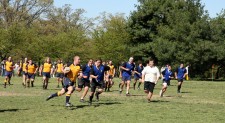 There has been a lot of talk in sports news today about whether Michael Vick, the latest quarterback for the New York Jets, should have been allowed to return to Sunday s game against the Chiefs shortly after being helped off with a head injury. Although he apparently passed concussion tests, he said after the game that he felt dizzy a concussion symptom. Yet he still passed the tests.
There has been a lot of talk in sports news today about whether Michael Vick, the latest quarterback for the New York Jets, should have been allowed to return to Sunday s game against the Chiefs shortly after being helped off with a head injury. Although he apparently passed concussion tests, he said after the game that he felt dizzy a concussion symptom. Yet he still passed the tests.
This incident is just another example of how Americans are dangerously relaxed with handling possible concussions in athletes. If this attitude is exhibited at the highest levels of professional sports the NFL one wonders how it s reflected among the many thousands of school-age players. Some answers may be found in an editorial published in this Sunday s New York Times, which reveals how colleges and universities are not doing nearly enough to protect athletes from effects of concussions, even after a concussion management plan was put into effect by the N.C.A.A. in 2010. That plan required all colleges and universities to remove athletes from practice or a game if they show any signs of a concussion, and also required education for athletes on concussion symptoms.
A study published in October in the American Journal of Sports Medicine found that although 90 percent of respondents at over 900 American universities reported their school having a concussion management plan, vast improvement is needed. Around a quarter of respondents reported their university had no process for annual athlete concussion education. Almost fourteen percent of respondents thought that either the coach or the athlete should have the final responsibility for deciding whether or not an athlete could return to the game after a concussion even though under the N.C.A.A. concussion policy, either a physician or physician s designee should have that responsibility.
While first concussions can have serious potential complications, including an increased risk of epilepsy and lasting brain injuries, athletes returning to play before recovering from a head injury may experience Second Impact Syndrome (SIS). SIS occurs when a person experiences a second concussion before symptoms of a first concussion have resolved, resulting in rapid and often fatal brain swelling. The mortality rate for SIS is close to 50 percent.
ACSH s Dr. Gil Ross had this comment: Clearly, it is crucial that athletes remain out of the game if they experience a concussion. The study, echoed by the editorial in today s paper, states that blame lies in part with the N.C.A.A., which needs to do a much better job of providing guidance for how to properly educate athletes, and is responsible for failing to outline consequences for unacceptable programs.